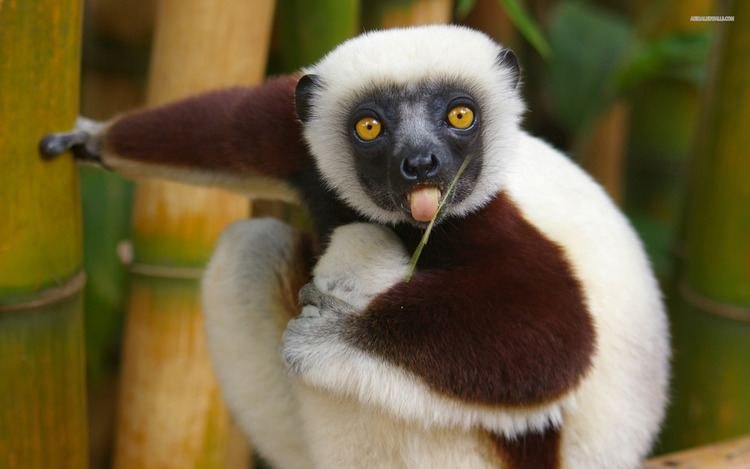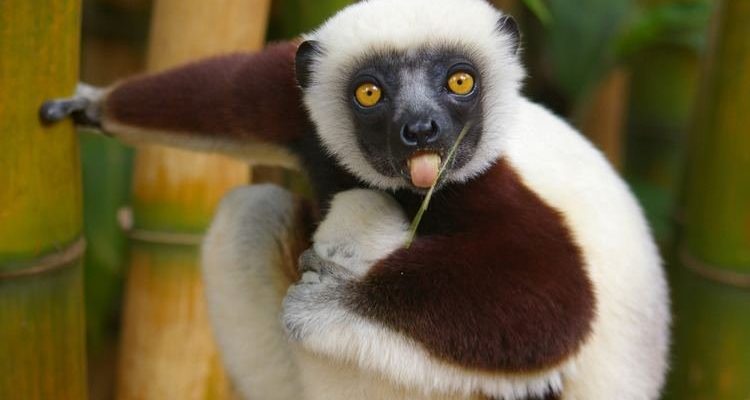
Sifakas are native to Madagascar, a place known for its rich biodiversity and quirky wildlife. While they may look similar to other lemurs, the sifaka has distinct features and behaviors that mark its uniqueness. So, whether you’re a wildlife enthusiast or just someone curious about nature, stick around. Here are ten fascinating facts that will have you enchanted by the sifaka.
1. Unique Locomotion: The Sifaka Shuffle
One of the most eye-catching things about sifakas is their mode of movement, often referred to as the “sifaka shuffle.” Instead of walking on all fours like many animals, sifakas are known for their impressive hopping style. Imagine a graceful ballet dancer leaping between tree branches. When they move on the ground, they’ll stand upright and use a combination of powerful hind legs to hop along. It looks almost like they’re dancing!
This unique way of getting around isn’t just for show. It’s practical too. Sifakas primarily live in the trees of Madagascar’s dry forests and rainforests, so their ability to leap through the canopy allows them to escape predators and access food sources high up in the trees.
2. Social Creatures: Living in Groups
Sifakas are social animals, often seen living in groups called troops. These troops usually consist of anywhere from 3 to 12 members. Just like a close-knit family, they spend their days grooming each other, playing, and resting together. You might be wondering why grooming is essential for them. It’s not just about keeping clean; grooming helps strengthen social bonds between members, reduces tension, and promotes overall troop harmony.
Within these groups, there’s a clear social structure. Typically, females are the dominant members, leading the troop. This matriarchal setup is quite different from many other animal societies where males take the lead. The female sifaka sets the pace for group activities, and the others follow her lead.
3. Diet: A Leafy Affair
When it comes to dining, sifakas are quite picky eaters. Their diet primarily consists of leaves, fruits, flowers, and some bark. This herbivorous diet might seem simple, but living in Madagascar’s unique ecosystems means they have access to an amazing variety of plants.
Interestingly, sifakas have a keen sense of what’s edible and what’s not. They can eat leaves that many other animals find unappetizing. This selective feeding is essential because it allows them to thrive in an environment where food can be scarce at times. It’s a perfect example of adapting to one’s surroundings.
4. Endemic to Madagascar: A Unique Home
Sifakas are found only in Madagascar, making them an endemic species. This means they’re unique to this island and nowhere else in the world. Madagascar itself is like a living laboratory of evolution, with many species found nowhere else. The isolation of the island has created a haven for diverse wildlife—sifakas included.
Unfortunately, this unique home comes with challenges. Madagascar faces significant environmental threats, including deforestation and habitat loss. As these incredible creatures rely on the forests for survival, they are vulnerable to these changes. Conservation efforts are crucial to ensure that sifakas continue to thrive in their native habitat.
5. The Call of the Sifaka: Vocal Communicators
If you’ve ever heard the sound of a sifaka calling, you might find it fascinating. Sifakas are quite vocal and have a range of sounds they use to communicate. Their calls can be loud and echo through the forests, almost like a natural music track providing a soundtrack to their daily activities.
These calls serve various purposes, from warning other sifakas of potential threats to maintaining social bonds within the troop. You know how you might text or call a friend just to check in? Well, for sifakas, vocalizations are their version of staying in touch!
6. Slow Reproduction: A Long Wait for Babies
Sifakas have a slow reproduction rate, which means they can take a while to raise their young. The gestation period lasts about five months, resulting in usually a single baby being born. These little ones are incredibly vulnerable at birth, relying heavily on their mothers for warmth, protection, and food.
The bond between mother and baby is strong. The mom carries her baby on her belly for the first few months, ensuring it stays safe as they navigate through the treetops. This slow reproductive rate is part of the reason why population numbers can decline quickly when faced with environmental threats.
7. Diversity of Species: More Than One Type of Sifaka
You might be surprised to learn that there are several species of sifaka, each with its own unique features and traits. The most well-known is the Verreaux’s sifaka, easily recognizable by its striking white fur and black face. However, there are others like the Coquerel’s sifaka and the Milne-Edwards’ sifaka, each with distinct colors and behaviors.
This diversity showcases the adaptability of sifakas. Each species has evolved to thrive in different Madagascar habitats, from the dry spiny forests to the lush rainforests. It’s a testament to the wonders of evolution, creating such varied yet fascinating creatures.
8. Threats and Conservation Efforts
Sadly, sifakas face numerous threats that endanger their populations. Deforestation, primarily due to agriculture and logging, poses significant risks. When their forest homes are destroyed, sifakas lose not only their habitat but also their food sources.
Fortunately, there are conservation efforts underway. Organizations are working hard to protect their natural habitats and raise awareness about the importance of these primates in the ecosystem. You might be wondering how you can help. Supporting wildlife conservation programs or simply spreading the word about the plight of these unique creatures can make a difference.
9. A Symbol of Madagascar’s Wilderness
In many ways, sifakas have become symbols of Madagascar’s rich natural heritage. Their unique behaviors, social structures, and appearance highlight the island’s incredible biodiversity. For locals and tourists alike, spotting a sifaka in the wild is a memorable experience, often creating lasting connections with the island’s wildlife.
By studying and appreciating these animals, we can better understand the importance of conservation and coexistence. Protecting the sifakas means preserving Madagascar’s wild heart for future generations.
10. A Window into Evolution
Sifakas can teach us a lot about evolution and adaptation. Their specialized habits and physical characteristics show how species change over time to meet environmental challenges. Understanding how the sifaka has evolved can shed light on the broader patterns of life on Earth.
As we face global challenges like climate change, looking at resilient species like the sifaka can offer insights into survival strategies for many species, including our own. It’s a reminder that every creature plays a role in the complex web of life.
In conclusion, the sifaka is more than just a cute face. It embodies the beauty and fragility of Madagascar’s ecosystems. By learning about these fascinating creatures, we can foster a deeper appreciation for wildlife and the importance of protecting our planet. So, the next time you hear about sifakas, you’ll have a treasure trove of knowledge to share with others!

